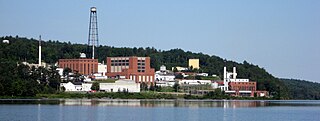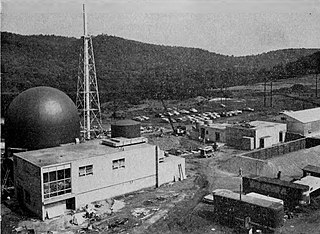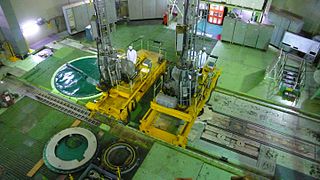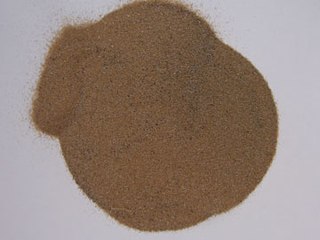Related Research Articles

The CANDU is a Canadian pressurized heavy-water reactor design used to generate electric power. The acronym refers to its deuterium oxide moderator and its use of uranium fuel. CANDU reactors were first developed in the late 1950s and 1960s by a partnership between Atomic Energy of Canada Limited (AECL), the Hydro-Electric Power Commission of Ontario, Canadian General Electric, and other companies.
Smiling Buddha was the code name of India's first successful nuclear weapon test on 18 May 1974. The nuclear fission type bomb was detonated in the Pokhran Test Range of the Indian Army in Rajasthan. As per the United States military intelligence, the operation was named as Happy Krishna. The Indian Ministry of External Affairs (MEA) described the test as a peaceful nuclear explosion.
NRX was a heavy-water-moderated, light-water-cooled, nuclear research reactor at the Canadian Chalk River Laboratories, which came into operation in 1947 at a design power rating of 10 MW (thermal), increasing to 42 MW by 1954. At the time of its construction, it was Canada's most expensive science facility and the world's most powerful nuclear research reactor. NRX was remarkable both in terms of its heat output and the number of free neutrons it generated. When a nuclear reactor such as NRX is operating, its nuclear chain reaction generates many free neutrons. In the late 1940s, NRX was the most intense neutron source in the world.

The Nyongbyon Nuclear Scientific Research Center (녕변원자력연구소) is North Korea's major nuclear facility, operating its first nuclear reactors. It is located in Nyongbyon County in North Pyongan Province, about 100 km north of Pyongyang. The center produced the fissile material for North Korea's six nuclear weapon tests from 2006 to 2017, and since 2009 is developing indigenous light water reactor nuclear power station technology.

Chalk River Laboratories is a Canadian nuclear research facility in Deep River, about 180 km (110 mi) north-west of Ottawa.
Atomic Energy of Canada Limited (AECL) is a Canadian Crown corporation and the largest nuclear science and technology laboratory in Canada. AECL developed the CANDU reactor technology starting in the 1950s, and in October 2011 licensed this technology to Candu Energy.

Homi Jehangir Bhabha, FNI, FASc, FRS(30 October 1909 – 24 January 1966) was an Indian nuclear physicist who is widely credited as the "father of the Indian nuclear programme". He was the founding director and professor of physics at the Tata Institute of Fundamental Research (TIFR), as well as the founding director of the Atomic Energy Establishment, Trombay (AEET) which was renamed the Bhabha Atomic Research Centre in his honour. TIFR and AEET served as the cornerstone to the Indian nuclear energy and weapons programme. He was the first chairman of the Indian Atomic Energy Commission and secretary of the Department of Atomic Energy. By supporting space science projects which initially derived their funding from the AEC, he played an important role in the birth of the Indian space programme.

The Bhabha Atomic Research Centre (BARC) is India's premier nuclear research facility, headquartered in Trombay, Mumbai, Maharashtra, India. It was founded by Homi Jehangir Bhabha as the Atomic Energy Establishment, Trombay (AEET) in January 1954 as a multidisciplinary research program essential for India's nuclear program. It operates under the Department of Atomic Energy (DAE), which is directly overseen by the Prime Minister of India.

The Saxton Nuclear Experiment Station, also known as the Saxton Nuclear Generating Station or Saxton Nuclear Experimental Corporation Facility, was a small nuclear power plant located in Bedford County, near Saxton, Pennsylvania.

Madras Atomic Power Station (MAPS) located at Kalpakkam about 80 kilometres (50 mi) south of Chennai, India, is a comprehensive nuclear power production, fuel reprocessing, and waste treatment facility that includes plutonium fuel fabrication for fast breeder reactors (FBRs). It is also India's first fully indigenously constructed nuclear power station, with two units each generating 220 MW of electricity. The first and second units of the station went critical in 1983 and 1985, respectively. The station has reactors housed in a reactor building with double shell containment improving protection also in the case of a loss-of-coolant accident. An Interim Storage Facility (ISF) is also located in Kalpakkam.
The advanced heavy-water reactor (AHWR) or AHWR-300 is the latest Indian design for a next-generation nuclear reactor that burns thorium in its fuel core. It is slated to form the third stage in India's three-stage fuel-cycle plan. This phase of the fuel cycle plan was supposed to be built starting with a 300 MWe prototype in 2016.
The Dhruva reactor is India's largest nuclear research reactor. It was the first nuclear reactor in Asia proper. Located in the Mumbai suburb of Trombay at the Bhabha Atomic Research Centre (BARC), it is India's primary generator of weapons-grade plutonium-bearing spent fuel for its nuclear weapons program. Originally named the R-5, this open pool reactor first went critical on 8 August 1985 after 10 years of construction. However, the unit did not attain full power until 1988. The reactor experienced at least one serious accident when 4 metric tons of heavy water overflowed from the reactor core in 1985 following vibration problems.
The Karachi Nuclear Power Plant is a large commercial nuclear power plant located at the Paradise Point in Karachi, Sindh, Pakistan.
The Prototype Fast Breeder Reactor (PFBR) is a 500 MWe sodium-cooled, fast breeder reactor that is being constructed at Kokkilamedu, near Kalpakkam, in Tamil Nadu state, India. The Indira Gandhi Centre for Atomic Research (IGCAR) is responsible for the design of this reactor, the Advanced Fuel Fabrication Facility at the Bhabha Atomic Research Centre in Tarapur is responsible for MOX fuel fabrication and BHEL is providing technology and equipment for construction of the reactor. The facility builds on the decades of experience gained from operating the lower power Fast Breeder Test Reactor (FBTR). At first, the reactor's construction was supposed to be completed in September 2010, but there were several delays. The Prototype Fast Breeder Reactor is scheduled to be put into service in December 2024, which is more than 20 years after construction began and 14 years after the original commissioning date, as of December 2023. The project's cost has doubled from ₹3,500 crore to ₹7,700 crore due to the multiple delays. The construction was completed on 4th March 2024 with commencement of core loading of the reactor hence paving the way for the eventual full utilization of India’s abundant thorium reserves.
Nuclear power is the fifth-largest source of electricity in India after coal, gas, hydroelectricity and wind power. As of November 2020, India has 23 nuclear reactors in operation in 8 nuclear power plants, with a total installed capacity of 7,380 MW. Nuclear power produced a total of 43 TWh in 2020–21, contributing 3.11% of total power generation in India. 10 more reactors are under construction with a combined generation capacity of 8,000 MW.

India's three-stage nuclear power programme was formulated by Homi Bhabha, the well-known physicist, in the 1950s to secure the country's long term energy independence, through the use of uranium and thorium reserves found in the monazite sands of coastal regions of South India. The ultimate focus of the programme is on enabling the thorium reserves of India to be utilised in meeting the country's energy requirements. Thorium is particularly attractive for India, as India has only around 1–2% of the global uranium reserves, but one of the largest shares of global thorium reserves at about 25% of the world's known thorium reserves. However, thorium is more difficult to use than uranium as a fuel because it requires breeding, and global uranium prices remain low enough that breeding is not cost effective.
Heavy Water Board (HWB) is a constituent unit under the Department of Atomic Energy in the Government of India. The organisation is primarily responsible for production of heavy water (D2O) which is used as a moderator and coolant in nuclear power as well as research reactors. Other than heavy water, the HWB is also engaged with production of nuclear grade solvents and extraction of rare materials. India is one of the largest manufacturers of heavy water in the world. Similarly, India has one of the world's largest fleets of pressurized heavy water reactors producing most of India's nuclear power supply.

Thorium-based nuclear power generation is fueled primarily by the nuclear fission of the isotope uranium-233 produced from the fertile element thorium. A thorium fuel cycle can offer several potential advantages over a uranium fuel cycle—including the much greater abundance of thorium found on Earth, superior physical and nuclear fuel properties, and reduced nuclear waste production. One advantage of thorium fuel is its low weaponization potential. It is difficult to weaponize the uranium-233 that is bred in the reactor. Plutonium-239 is produced at much lower levels and can be consumed in thorium reactors.
Chaitanyamoy Ganguly is an Indian nuclear scientist and a former head of the Nuclear Fuel Cycle and Materials Section of the International Atomic Energy Agency (IAEA), credited with many innovations in the field of nuclear material science. He was honored by the government of India in 2002, with the fourth-highest Indian civilian award of Padma Shri.
The Fast Breeder Reactor-600 (FBR-600) or Indian Fast Breeder Reactor (IFBR) or Commercial Fast Breeder Reactor (CFBR) is a 600-MWe fast breeder nuclear reactor design presently being designed as part of India's three-stage nuclear power programme to commercialise the Prototype Fast Breeder Reactor built at Kalpakkam. The Indira Gandhi Centre for Atomic Research (IGCAR) is responsible for the design of this reactor as a successor for Prototype Fast Breeder Reactor (PFBR). The 1st twin unit would come up within the BHAVINI premises at Madras Atomic Power Station at Kalpakkam, close to the PFBR site itself.
References
- ↑ "50-Yr Old Research N-Reactor CIRUS Shut Down". Outlook.
- ↑ "Research N-reactor CIRUS to shutdown permanently on December 31". DNA. 18 December 2010.
- ↑ Evans, Brian L. (2013). The Remarkable Chester Ronning: Proud Son of China . University of Alberta. p. 189. ISBN 9780888646637.
Canada India Reactor Utility Services.
- ↑ "Canadian-Indian Reactor, U.S." NTI. Archived from the original on 17 February 2016. Retrieved 10 November 2012.
- 1 2 "Cirus reactor". Bhabha Atomic Research Center. Archived from the original on 9 July 2007. Retrieved 2007-04-09.
- ↑ Exporting Disaster ~ The Cost of Selling CANDU Reactors (3). Ccnr.org. Retrieved on 2013-12-06.
- 1 2 Gopal, Neena (2006-07-03). "PM to announce Cirus reactor shutdown". Gulfnews. Archived from the original on 19 October 2008. Retrieved 2007-04-09.
- ↑ "Research N-reactor CIRUS to shutdown[sic] permanently on December 31". DNAIndia. 2010-12-18.